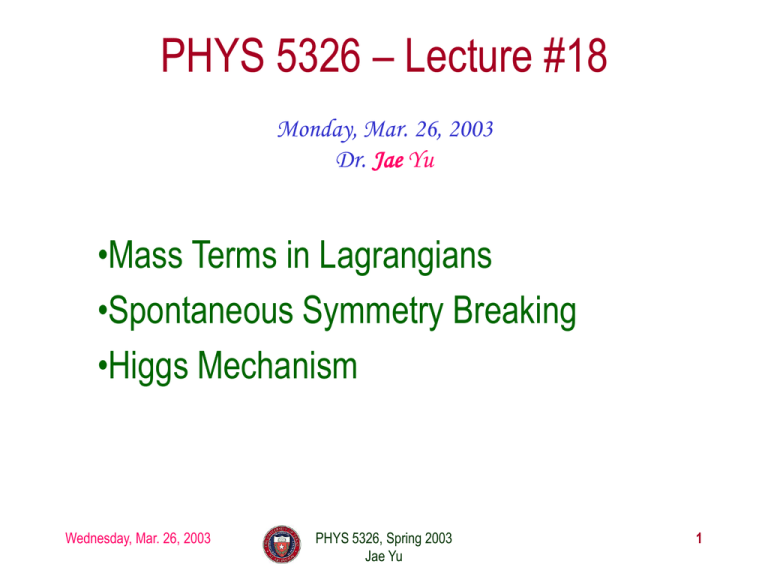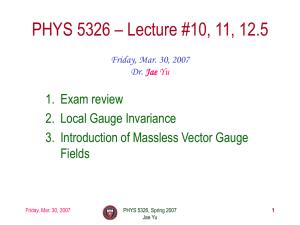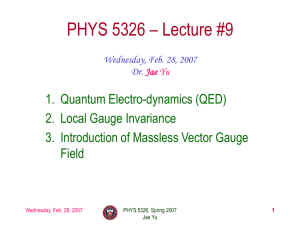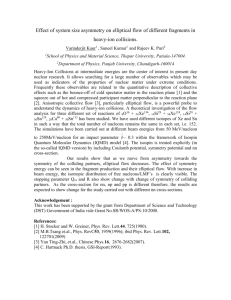Mass terms in Lagrangians and Symmetry Breaking
advertisement

PHYS 5326 – Lecture #18 Monday, Mar. 26, 2003 Dr. Jae Yu •Mass Terms in Lagrangians •Spontaneous Symmetry Breaking •Higgs Mechanism Wednesday, Mar. 26, 2003 PHYS 5326, Spring 2003 Jae Yu 1 Announcements • Prepare a semester project progress for next Monday, Mar. 31 • Prepare slides for improved cuts, explanations, plots, interpretations and the plans to complete the project • The presentation can be up to 10 minutes each. • Remember that you need to submit a report. • No written final exams – Will keep the mid-term proportion at 20%. – Homework takes 20%. – Semester project • Presentation 30% • Note 30% Wednesday, Mar. 26, 2003 PHYS 5326, Spring 2003 Jae Yu 2 Semester Projects • DØ Data Analysis – Need to setup DØ Data Analysis systems • See http://wwwd0.fnal.gov/computing/algorithms/howto/tutorial.html for tutorial • Consists of – A >=10 page report (must become a UTA-HEP note) – A 30 minute presentation • Topics – Number of events vs Number of jets for W and Z events Wednesday, Mar. 26, 2003 PHYS 5326, Spring 2003 Jae Yu 3 Introducing Mass Terms Consider a free Lagrangian for a scalar field, f: 1 f L f f e 2 No apparent mass terms unless we expand the second term and compare L with the Klein-Gordon L: 1 1 1 2 4 6 L f f 1 f f f .... 2 2 6 LKG 2 1 1 mc 2 f f f 2 2 where m 2 / c Wednesday, Mar. 26, 2003 PHYS 5326, Spring 2003 Jae Yu 4 Introducing Mass Terms in Potential Consider a Lagrangian for a scalar field, f, in a potential: 1 1 2 2 1 2 4 L f f f f 2 2 4 Mass term (f2 term) has the wrong sign unless mass is imaginary. How do we interpret this L? In Feynman calculus, the fields are fluctuation (perturbation) from the ground state (vacuum). Expressing L =T-U, the U 1 2f 2 1 2f 4 2 4 potential energy U is Wednesday, Mar. 26, 2003 PHYS 5326, Spring 2003 Jae Yu 5 Introducing Mass Terms in Interactions The field that minimizes U is f / To shift the ground state to occur at 0, we introduce the new variable, h: h f / Replacing field, f, with the new field, h, the L becomes 1 1 2 4 1 2 2 2 3 L h h h h h / 2 4 4 Mass term 3point vtx 4point vtx Comparing the modified L with LKG, the mass is m Wednesday, Mar. 26, 2003 2 PHYS 5326, Spring 2003 Jae Yu 2 / c 6 Spontaneous Symmetry Breaking The original lagrangian, L, 1 1 2 2 1 2 4 L f f f f 2 2 4 is even and thus invariant under f f. However, the new L 2 1 1 2 4 1 2 2 2 3 L h h h h h / 2 4 4 has an odd term that causes this symmetry to break since any one of the ground states (vacuum) does not share the same symmetry as L. Wednesday, Mar. 26, 2003 PHYS 5326, Spring 2003 Jae Yu 7 Potential and Symmetry Breaking Not symmetric about this axis 1 1 2f 2 2f 4 2 4 Symmetric about this axis Wednesday, Mar. 26, 2003 PHYS 5326, Spring 2003 Jae Yu 8 Spontaneous Symmetry Breaking While the collection of ground states does preserve the symmetry in L, the Feynman formalism allows to work with only one of the ground states. Causes the symmetry to break. This is called “spontaneous” symmetry breaking, because symmetry breaking is not externally caused. The true symmetry of the system is hidden by an arbitrary choice of a particular ground state. This is a case of discrete symmetry w/ 2 ground states. Wednesday, Mar. 26, 2003 PHYS 5326, Spring 2003 Jae Yu 9 Spontaneous Breaking of a Continuous Symmetry A lagrangian, L, for two fields, f1 and f2 can be written 1 1 L f1 f1 f 2 f 2 2 2 1 2 2 1 2 2 2 2 2 f1 f 2 f1 f 2 2 4 is even and thus invariant under f1, f2 f1, f2 . The potential energy term becomes 1 2 2 1 2 2 2 U f1 f2 f1 f 22 2 4 w/ the minima on the circle: Wednesday, Mar. 26, 2003 f 2 1,min PHYS 5326, Spring 2003 Jae Yu f 2 2,min / 2 2 10 2 Spontaneous Breaking of a Continuous Symmetry To apply Feynman calculus, we need to expand about a particular ground state (the “vacuum”). Picking f1,min / and f2,min 0 And introduce two new fields, h and x, which are fluctuations about the vacuum: h f1 / Wednesday, Mar. 26, 2003 and x f2 PHYS 5326, Spring 2003 Jae Yu 11 Spontaneous Breaking of a Continuous Symmetry The new L becomes 1 1 2 2 L h h h x x 2 2 2 1 2 3 2 4 4 2 2 h hx h x 2h x / 4 4 3point vtx LKG of the field h w/ the mass mh 2 / c 2 Lfree of the massless field x 4point vtx Wednesday, Mar. 26, 2003 PHYS 5326, Spring 2003 Jae Yu 12 Spontaneous Breaking of Continuous Global Symmetry One of the fields is automatically massless. Goldstone’s theorem says that breaking of continuous global symmetry is always accompanied by one or more massless scalar (spin=0) bosons, called Goldstone Bosons. This again poses a problem because the effort to introduce mass to weak gauge fields introduces a massless scalar boson which has not been observed. This problem can be addressed if spontaneous SB is applied to the case of local gauge invariance. Wednesday, Mar. 26, 2003 PHYS 5326, Spring 2003 Jae Yu 13 Higgs Mechanism L in page 10 can be simplified by combining two real * 2 2 f f i f ; f f f f fields into one complex field 1 2 1 2 Using this new form of the field, the L looks exactly like that of a single scalar field 1 1 2 * 1 2 * * L f f f f f f 2 2 4 2 Now the rotational symmetry becomes invariance i f e f. under U(1) gauge transformation, Wednesday, Mar. 26, 2003 PHYS 5326, Spring 2003 Jae Yu 14 Higgs Mechanism L can be made invariant under local gauge transformation by introducing a vector field, A, and replacing the partial derivatives with covariant ones. The new L then becomes 1 iq * iq L A f A f 2 c c 1 2 * 1 2 * 2 1 f f f f F F 2 4 16 We then can break the symmetry as we did before by introducing new fields h f1 / and x f2 . Wednesday, Mar. 26, 2003 PHYS 5326, Spring 2003 Jae Yu 15 Higgs Mechanism The new L is written in terms of h and x as Lfree of the massless field x 1 1 2 2 L h h h x x 2 2 2 1 1 iq q F F A A 2 i x A 16 2 c c 2 q 1 2 q 2 h x x h A h x h A A 2 c c 2 2 1 2 3 2 4 4 2 2 h hx h x 2h x / 4 4 LKG of the field h w/ the mass mh 2 / c Wednesday, Mar. 26, 2003 Lproca of the free gauge field x w/ the mass m 2 q / c A PHYS 5326, Spring 2003 Jae Yu 16 Higgs Mechanism Issues with the new L are the unwanted Goldstone boson x and the term x q 2i x A c A which can be interpreted as one point vertex interaction between scalar field x and vector field A. This kind of terms indicate that the fundamental particles in the theory are identified incorrectly. Both problems can be resolved exploiting gauge invariance of L. Wednesday, Mar. 26, 2003 PHYS 5326, Spring 2003 Jae Yu 17 Homework •Derive the new L in page 7 (everyone other than BS). •Derive the new L for two fields in page 12 (BS only). •Show that one of the two scalar fields could be massless when the choice of minima were made at f1 2 ; f2 2 •Derive the new L in page 16. •Due Monday, Apr. 7. Wednesday, Mar. 26, 2003 PHYS 5326, Spring 2003 Jae Yu 18





